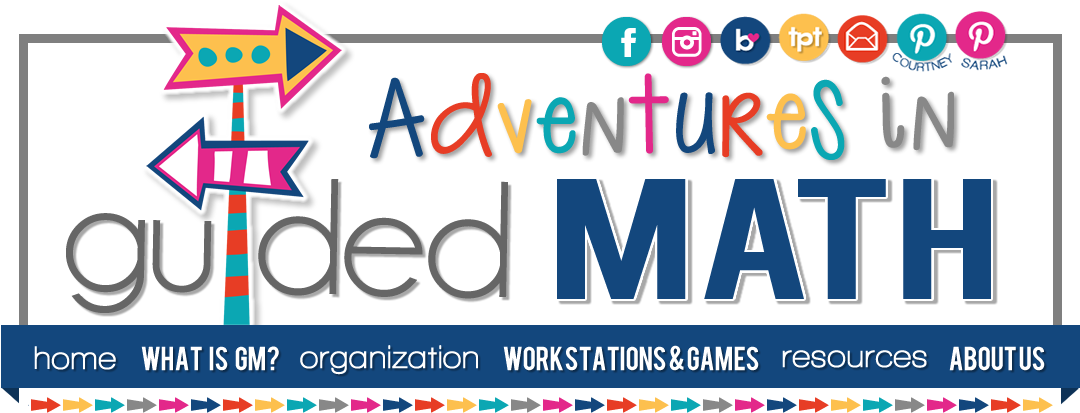To read past chapter posts, visit the Number Talks Book Study Archive!
Chapter 4: How Do I Design Purposeful Number Talks for the K-2 Classroom?
Chapter 4 is nicely organized into sections for kindergarten, first, and second grade. Even though I am a second grade teacher, I found it important to delve into the other grades as well. I recently began number talks in the whole group setting, but I have always had "chats", as we call them, in small guided math groups. For this reason, the information present for each grade level is equally as valuable. Plus, I think it important to understand where our kids come from and where they are headed.
I will try to discuss the essence of the information presented for each grade level. In order to benefit fully from this chapter, that also presents numerous examples of number talks that can be used at each grade level, you will need to get a copy of the book--highly recommended. :0) At the same time, I have inserted a couple of kindergarten number talk videos for those who do not have the book.
The chapter begins by overviewing the contents of the chapter and the focus of number talks at each grade level: kindergarten--fluency, first grade--addition, and second grade--addition and subtraction.
In kindergarten, the focus of number talks should be talking about numbers, counting, building fluency with small numbers, and one-to-one correspondence. Additionally, all of the skills mentioned can be developed through the use of dot images, rekenreks, and five and ten frames.
Dot Images
What is a dot image? A dot image is simply a specific number of dots arranged in a particular way.
Why use dot images? Parrish stresses that dot images provide opportunities for students to work on counting, subitize, see numbers in different ways, and learn different combinations of numbers.
Here's a great article about subitizing:
Subitizing: What is It? Why Teach It?
Subitizing: What is It? Why Teach It?
You can also check out the following video of a kindergarten number talk using ten frames and dot images. It is one of the videos included on the DVD that accompanies the book (found on YouTube). It's wonderful to hear kindergartens verbalizing their understanding.
Dot images are SO simple to make. Got some index cards and dot stickers (found by the garage sale tags)? You have all you need to create! I also like to use paper plates--a little tip that I was given a few summers ago.
Rekenreks
What is a rekenrek? A rekenrek has two strings of beads positioned parallel to one another. Each string has ten beads of two different colors (typically red and white). One row of beads can be used at a time (fluency to 10), or both strings can be used together (fluency to 20).
Why use rekenreks? Rekenreks help students see the relationship between numbers, subitize, and build fluency.
You will find a wonderful series of number talks using the rekenrek (from 3 to 10) for kindergartens in chapter 4.
Also, enjoy the following rekenrek number talk from MathSolutions (also included on DVD) from YouTube.
As you see in the video, the kindergartners are using homemade rekenreks.
Rekenreks to Purchase
Digital Rekenreks
Brilliant Beadstring (ictgames.com)
Number Rack (iPad app)
Five and Ten Frames
Nowadays, I would say most teachers know what five and ten frames are. Five and ten frames are excellent for helping students visualize addition and subtraction, understand place value, subitize, and build fluency.
As you saw in the first video, ten frames can easily be used in number talks and powerful discussions and reasoning arises.
Parrish provides a collection of five and ten frame number talks. I especially liked her discussion of how posing different questions about ten frames can change the purpose and focus of each ten frame.
Need ten frames? Feel free to download this freebie!
In first grade, dot images, rekenreks, and ten frames are equally as important, yet you will see number sentence number talks (addition) are also included in the chapter. The three tools, along with number sentences, are nicely interwoven by strategy from counting all/counting on, doubles/near doubles, to making ten. This allows a natural progression from the use of tools to number sentences.
Second grade number talks are designed to "foster specific computation strategies". For this reason, you will find that the number talks presented are organized by strategy and categories. Categories include: introductory number talks that encourage a specific strategy, number talks for students that are successfully using a selected strategy, and those for students to use and extend a targeted strategy.
As a second grade teacher, I have found this especially useful. Addition and subtraction number talks are presented with simple instructions for each. I choose my number talks carefully, and Chapter 4 is a great resource along with the equations I design myself.
If you teach K-2, I am sure you found, or will find, this chapter just as useful as I did!
We would love to hear your experiences with number talks or your thoughts about using them with your students. Please feel free to share in a comment!
AND, keep those questions coming! Sherry Parrish, the author of Number Talks, will be doing a Q&A after the completion of our book study! Feel free to email us with any questions you have for Sherry. You may send questions to guidedmathadventures@gmail.com

Lastly, stop back this Sunday for Chapter 5: Student Thinking and Number Talks in the 3-5 Classroom! Looking forward to it!
All the best--



No comments:
Post a Comment